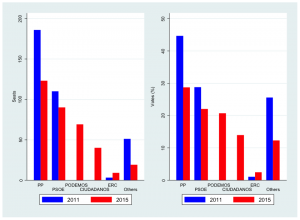By Ignacio Lago
Universitat Pompeu Fabra, Barcelona
On December 20 2015 the twelfth national election after the restoration of democracy in the seventies was held in Spain. The election revolved around the consequences of the economic crisis, corruption and the relationship between Spain and Catalonia. The two national established parties, PP and PSOE, have been challenged by two new national parties, Podemos and Ciudadanos. As a result the Congress of Deputies in 2015 is the most fragmented we have seen since the II Republic in the thirties, the first democratic experience in Spain.
Four features make this election quite exceptional in the Spanish electoral history.
- Despite winning the election, the ruling party, the center-right Partido Popular (Popular Party PP), has suffered the highest loss of support, 63 seats less than four years ago, since the disappearance of the UCD, the party which lead the democratic transition, in 1982. However, the Socialist Party (PSOE) has not taken advantage of this loss of support. It is again the main opposition party, but with only 90 seats, 20 less than in 2011, its worst-ever results.
- The 29 percent of the votes and 123 (out of 350) seats won by PP in the 2015 election is the lowest support ever reached by the winner of a national election in Spain. In the previous eleven elections the number of seats got by the winner has fluctuated from 202 (in 1982) to 156 (in 1996) and then the selection of a Primer Minister (which demands majority in the first voting in the Parliament and plurality –more yes than no- in a hypothetical second voting) and the formation of a government has never been problematic: no coalition governments have been formed in Spain.
- Two new parties, the far-left Podemos (We can) and the center-right Ciudadanos (Citizens), have very successfully entered the Parliament. In the electoral history before 2015, the most successful third party was the ex-communist Izquierda Unida (United Left) with 21 seats in 1996. In 2015 Podemos has got 69 seats and Ciudadanos 40. As a result, the support of the two main parties, the PP and the PSOE, the 51 percent of the votes (almost 25 points less than four years ago), is the lowest since the founding election in 1977.
- For the first time in Spain the name of the future Prime Minister and the composition of the government is uncertain. The scenario is particularly open as there have been no positive coalition signals before the election, but negative. Only two options are on the table. An agreement or coalition between PP and PSOE or an agreement or a coalition between PSOE, Podemos, and subnational parties. In the former, the problem is that the platforms of the two parties are not closed; in the latter, the main problem is that Podemos is in favour of a referendum about the independence of Catalonia, while the PSOE is clearly against it.
If a Primer Minister is not elected before April …. There will be elections again!
Figure 1: Seats and votes in the 2011 and 2015 elections in Spain

